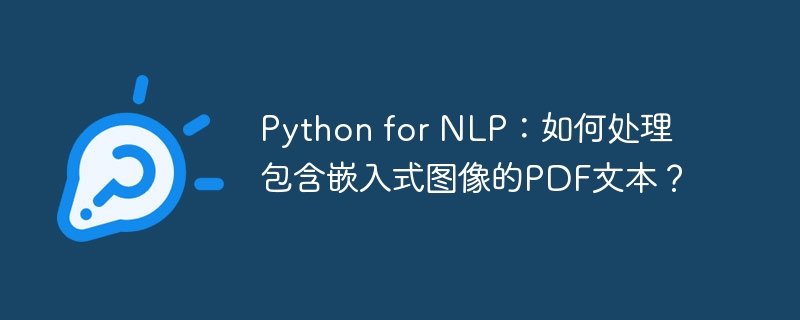

Python for NLP: How to handle PDF text containing embedded images?
Abstract:
This article will introduce how to use Python to process PDF text containing embedded images. We will use the PyPDF2 library to parse PDF documents and then use the Python Imaging Library (PIL) to process embedded images.
Introduction:
In natural language processing (NLP), processing PDF text containing embedded images is a common task. Such text is usually obtained from scanned documents or e-books, and the text and image need to be separated for subsequent processing. Python is a powerful programming language with many libraries for NLP. In this article, we will demonstrate how to process this type of PDF text using Python.
Steps:
Install the necessary libraries:
Before you start, you need to install the PyPDF2 and PIL libraries. These libraries can be installed using the following command:
pip install PyPDF2 pip install pillow
Import the required libraries:
Before writing the code, first import the required libraries:
import PyPDF2 from PIL import Image
Parse PDF documents:
Use the PdfFileReader method in the PyPDF2 library to parse PDF documents:
def extract_text_from_pdf(pdf_path): text = '' with open(pdf_path, 'rb') as file: pdf = PyPDF2.PdfFileReader(file) for page in range(pdf.getNumPages()): text += pdf.getPage(page).extractText() return text
Get embedded images:
Use the PyPDF2 library The getPage method can get the individual pages of the PDF document. Then, use the extract_images method of the object returned by the getPage method to extract the embedded images. The extracted image will be returned as a dictionary, where the key is the object number of the image and the value is a tuple containing the binary data of the image and the image information of the image.
def extract_images_from_pdf(pdf_path): images = {} with open(pdf_path, 'rb') as file: pdf = PyPDF2.PdfFileReader(file) for page in range(pdf.getNumPages()): page_images = pdf.getPage(page).extract_images() for obj_num, image in page_images.items(): images[obj_num] = image[0] return images
Saving embedded images:
After obtaining the embedded image, you can use the Image.frombytes method in the PIL library to create a PIL image object. The image can then be saved to a local file using the save method.
def save_images(images, output_dir): for obj_num, image_data in images.items(): image = Image.frombytes(**image_data) image_path = f"{output_dir}/{obj_num}.jpg" image.save(image_path)
Full sample code:
Here is a complete sample code that demonstrates how to handle PDF text containing embedded images:
import PyPDF2 from PIL import Image def extract_text_from_pdf(pdf_path): text = '' with open(pdf_path, 'rb') as file: pdf = PyPDF2.PdfFileReader(file) for page in range(pdf.getNumPages()): text += pdf.getPage(page).extractText() return text def extract_images_from_pdf(pdf_path): images = {} with open(pdf_path, 'rb') as file: pdf = PyPDF2.PdfFileReader(file) for page in range(pdf.getNumPages()): page_images = pdf.getPage(page).extract_images() for obj_num, image in page_images.items(): images[obj_num] = image[0] return images def save_images(images, output_dir): for obj_num, image_data in images.items(): image = Image.frombytes(**image_data) image_path = f"{output_dir}/{obj_num}.jpg" image.save(image_path) if __name__ == '__main__': pdf_path = 'example.pdf' output_dir = 'output' text = extract_text_from_pdf(pdf_path) print('Extracted Text:', text) images = extract_images_from_pdf(pdf_path) save_images(images, output_dir) print('Images Saved.')
Conclusion:
Using Python to process PDF text containing embedded images can become an important part of your NLP workflow. This article explains how to use PyPDF2 and the PIL library to parse PDF documents and process embedded images. By using these libraries, text and images can be easily separated and further processed and analyzed.
References:
The above is the detailed content of Python for NLP: How to handle PDF text containing embedded images?. For more information, please follow other related articles on the PHP Chinese website!




